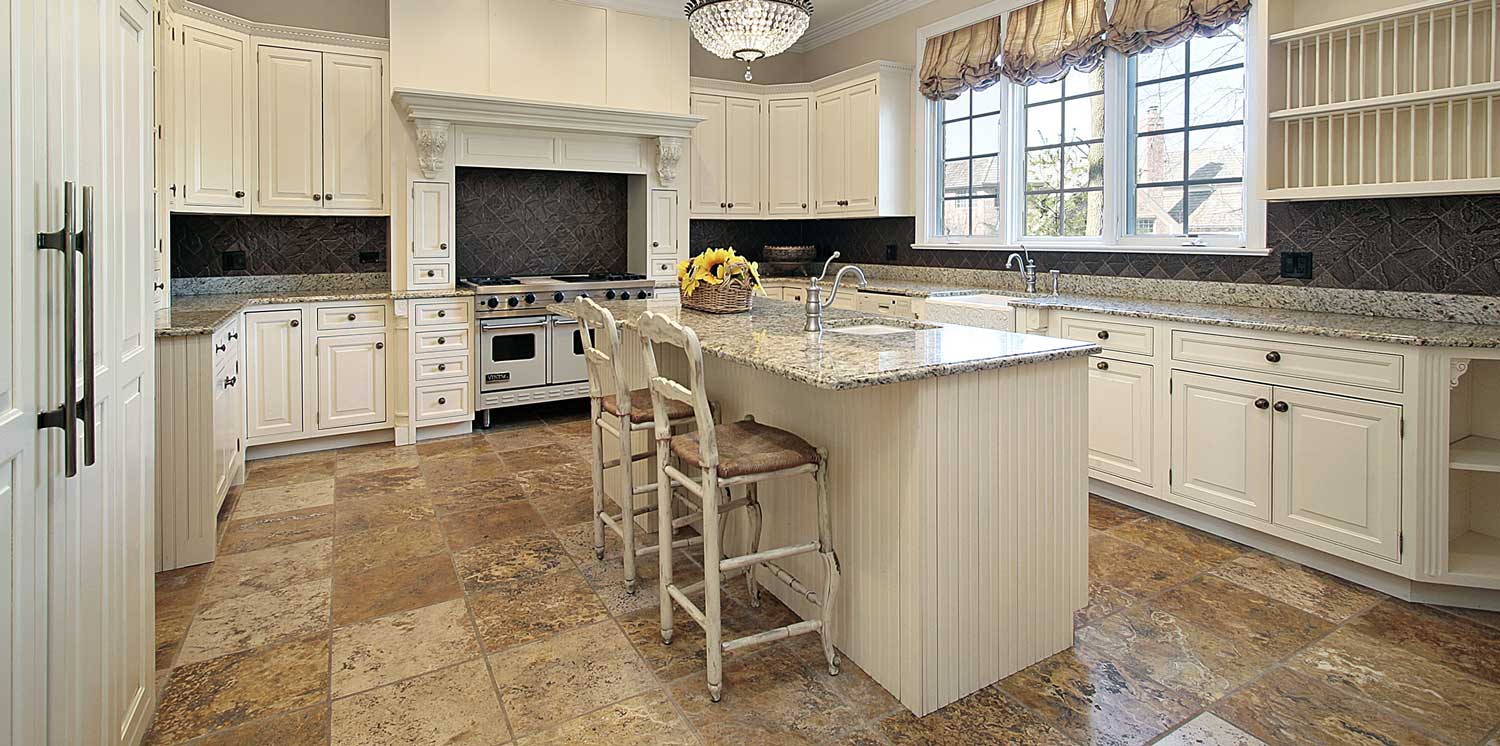Cost to Install a Tile Floor – 2025 Price Calculator
Tile floors are a popular option for homeowners, chosen for their beauty and durability. Tile floors can be used anywhere in the home, from foyers and mudrooms to kitchens and bathrooms.
There are many different types of tile flooring, which can impact their style, cost, and suitability for a specific space. All of these attributes can impact the overall cost of a tile floor. Keep reading to learn more about the cost of installing tile flooring.
Tile Flooring Cost Calculator
Enter the size of your project and select the material and services you're interested in to estimate the cost of the project using 2025 price data. Continue reading below to learn more about what to expect for a tile flooring project.
On this page:
How Much Does Tile Flooring Cost?
No matter where your tile floor is installed, it may see a lot of traffic and activity. Mudrooms and hallways may see a lot of foot traffic as well as things like mud, snow, and sand.
In a kitchen, cooking and dishwashing can mean splashes of water, food, or grease occur on the walls or floor. In a bathroom, wet floors can be a part of everyday life.
Tile is a fantastic flooring choice since it’s often affordable, and many types are easy to maintain. Mopping and brushing can be faster and easier than vacuuming, and many types of tile are less susceptible to stains and damage than materials like carpet or hardwood.
As such, it’s clear that hard floor surfaces can offer a lot of benefits to homeowners. Still, it’s always helpful to know how much these things cost, particularly if you need a new floor installed immediately.
Installing 150 square feet of tile flooring often costs $1,350 to $3,750. The most popular type of tile to install in the home is either a porcelain or a floor-rated ceramic tile, which have average costs between $9 and $25 per square foot installed.
Keep in mind that you can also use high-end rectified porcelain as well as some stone tiles, which can increase your costs per square foot to as high as $50 a foot. Here are factors that influence the cost of tiling a floor and some examples of specific prices for you to consider:

Type of Tile – Ceramic, Porcelain, or Natural Stone
The type of tile is the number one factor that will impact the cost of your new floor. Tiles range widely in price depending on the type, brand, and durability.
You can pay as little as approximately fifty cents per square foot up to $15 or $30 dollars per square foot. If you’re overwhelmed by the variety of materials and styles available and are uncertain which to choose, you should pick an overall price that you’re willing to pay for materials and stick to it.
Materials include ceramic, porcelain, and natural stone. The size of each tile will also play a role in the cost, as it can be more difficult to lay larger tiles which will have an impact on labor. Larger tiles also require less grout and finishing time, however, while mosaics require more.
Below are the costs of most types of tiles per square foot, uninstalled.
| Tile Material | Price Per Sq Ft |
|---|---|
| Ceramic | $2 – $20 |
| Porcelain | $4 – $30 |
| Travertine | $3 – $30 |
| Slate | $4 – $10 |
| Marble | $5 – $50 |
Styles and Patterns
Using specific styles of tile can be more time-intensive to install than others. Unfilled travertine tile requires much more time to achieve a great look than a typical ceramic tile installation.
Different patterns can cost more to install to lay out and may result in waste. For example, laying out tiles in a herringbone or diagonal pattern can result in 20% more waste for offcuts. See several tile layout patterns and the approximate waste of each.
Type and Size of Room
The type and size of the room you intend to tile will make a huge difference in the overall price. The type of room dictates which tile is best, and sometimes the best type is the most expensive.
For example, if you’re tiling a kitchen floor, stain-resistant porcelain is a more popular choice than natural stone because it doesn’t stain. While it looks beautifully rustic, natural stone can stain over time as it is a more permeable material. Sometimes practicality will outweigh aesthetic considerations.
You can calculate the amount of tile you need by entering your project dimensions: the width and length of the space and the size of the tile (if these measurements are available). Moreover, if you already know the price per square foot, you can calculate the amount of flooring material you need as well as the estimated cost by multiplying by the size of the room in square feet.
Labor Costs
Tiling projects can require a high level of skill, especially when using higher-end materials or intricate patterns. Most contractors charge about $5 to $9 per square foot to install tile. The complexity of the project, type of materials used, skill-level of the contractor, and geographic region can all affect the cost.
Large tiles can be more difficult to install because they require back buttering and leveling to prevent corners from sticking up. Mosaic tiles are installed by the sheet, which may be simple, but they require more grout to finish. Most natural stone needs to be sealed prior to grouting, which will also increase labor costs.
Tile Flooring Tips
- To ensure a great tile floor installation, use these tips regardless of the type of tile you are installing.
- Purchase all your tile at once and make sure it’s all from the same dye lot. Some tiles have more variation than others; if you are purchasing a tile with a lot of variation, like a natural stone, ask to see pictures of the current lots before purchase.
- Do a dry layout before installing. Take tiles from several boxes at once and blend them for even color distribution. This is very important with stone tiles, particularly slate and travertine tiles.
- Use a tile wet saw to cut floor tile rather than a score and snap method. For porcelain tile, use a diamond-tipped blade, and change it often.
- If your tile is very textured, use a grout release on porcelain and ceramic before grouting, and for natural stone, use a sealer to help make the cleanup easier.
- Unless your tiles have been rectified – or machined to have even edges – do not butt them together. Leave at least 1/8 inch of space between straight tiles and 1/4 inch between tumbled and rustic tiles.
- Use sanded grout in anything above 1/16 to 1/8 inch and unsanded in anything smaller. Stain-resistant grouts or “presealed” grouts are available to help prevent discoloration over time.
- Use a membrane under tiles used in showers and other very wet areas, particularly when using marble to prevent discoloration.
If your floor is unlevel, and cannot be leveled, use mosaic tiles to help prevent cracking over time.
Frequently Asked Questions
Is tile cheaper than hardwood?
The majority of the time, yes. This will vary, though, by both the type of hardwood and the type of tile you choose, as both do have a range of costs.
Do tile floors increase home value?
They may, but this will depend on several things, including the area you live in, where the tiles are installed, and what types of tiles you are putting in.
Is it cheaper to install tile yourself?
It can be, but keep in mind that not all tile is simple to install. While some projects may be done easily DIY, some may require professional assistance to be done properly.
All pricing information on this page is based on average industry costs, and is subject to variance for project-specific materials, labor rates, and requirements.


